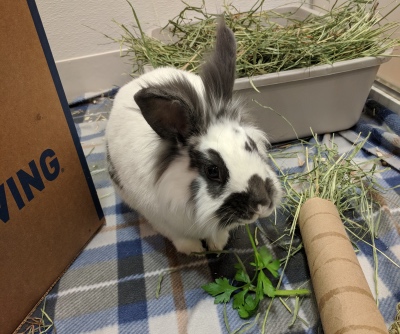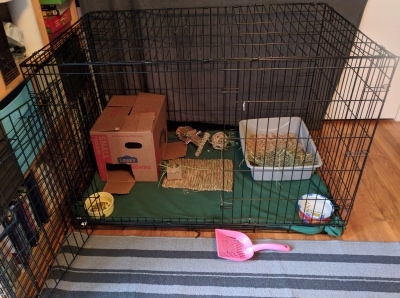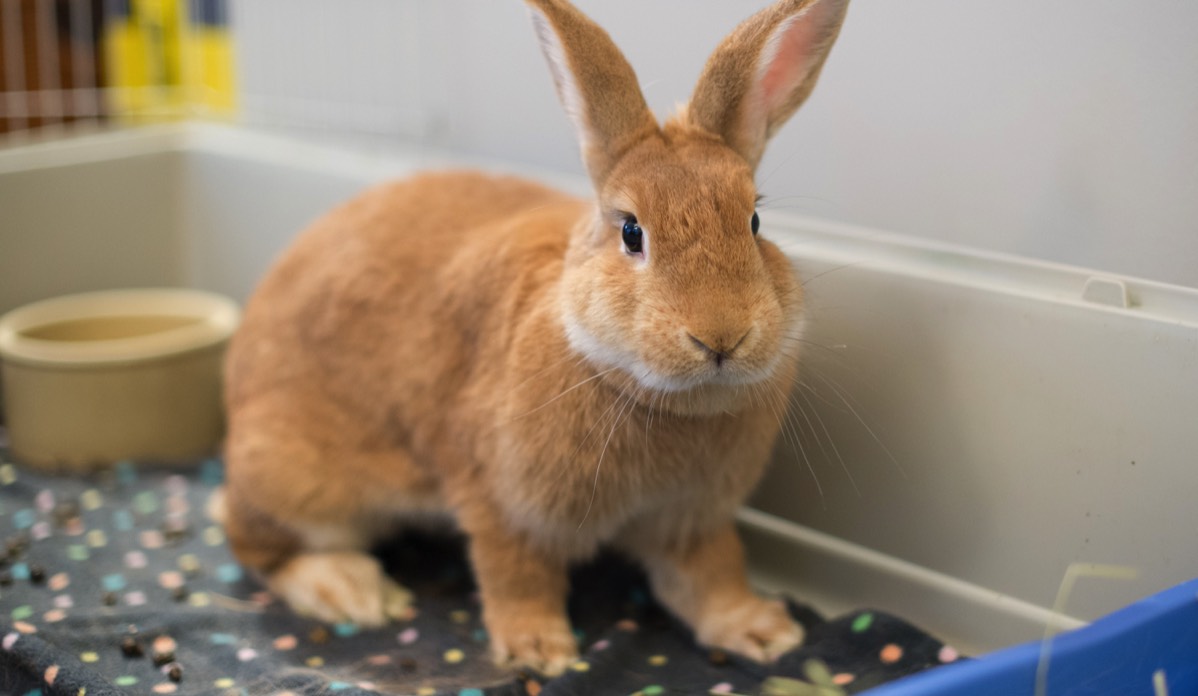
Tips for New Rabbit Foster Homes
Saturday, June 9, 2018
by Michelle Underhill, with input from other Triangle Rabbits foster homes.
Fostering is a great way to help animals in their journeys to finding a home. Triangle Rabbits has a network of foster homes, and also helps by coordinating the rabbit foster homes for the SPCA of Wake County. Many people have questions about fostering, so this month we are sharing some tips from our veteran foster families.
Why are foster homes needed for rabbits?

There are a handful of reasons why rabbits need foster homes. The most common is the rabbit hasn’t yet been spayed or neutered. As such, the rabbit remains in foster care until s/he has been spayed or neutered and can be available for adoption. Another reason is there is limited space on the adoption floor at AniMall, where Triangle Rabbits has space for adoptable rabbits, and at the SPCA of Wake County. After their spay/neuter surgery, rabbits remain in foster care until space is available. The third reason rabbits might be in foster care is because of a medical issue requiring special treatment, until the rabbit has recovered from the illness or condition.
If you are not yet fostering, but are interested in joining our foster team, visit http://trianglerabbits.org/volunteer/foster.html for more information and for a link to the foster interest form.
Quarantine tips
Foster rabbits should be kept apart from other animals in the house. As prey animals, rabbits hide illness. Keeping a foster rabbit away from other animals better ensures the health and safety for all. Rabbits are also territorial. So, if you have rabbits of your own, they likely will not want another rabbit in their space. Territorial marking might occur. Dogs or other animals might be overly interested in a rabbit, or the rabbit might be stressed by other animals in their space which could trigger underlying medical issues to come out.
Wash your hands when moving between your animals and the foster rabbit. One tip for ensuring your own animals’ health is to feed and clean up after your own animals first. Then, wash your hands and feed or clean up after the foster animals.
Remember to wash any items that you might use for foster rabbits, such as bowls or blankets, separately from your resident rabbit’s things. Foster rabbits should have their own accessories, including a hiding box, that are not shared with any of your personal rabbits.
Housing and care tips

Many rabbits have great litter habits, but some come in without having experience with litter boxes. When unsure of a rabbit’s litter habits, you may wish to put a fleece blanket or towels underneath the cage or pen where they will be to better protect the floors. For rabbits that are not litter trained, a vinyl flooring remnant from the hardware store is a great investment. It protects the floor and can be sanitized easily and reused.
Extra large dog crates or dog exercise pens work great as foster housing. A foster cage may be checked out from Triangle Rabbits if you do not have one available. A fleece blanket should be used at the bottom of their cage.
Additional tips on housing, litter training, and more may be found in the “Care” section of the Triangle Rabbits website.
Feeding foster rabbits
Hay is the most important part of a rabbit’s diet. Rabbits should be offered unlimited high quality grass hay, such as timothy or orchard grass, and the recommended amount of Oxbow pellets for their size and estimated age. Often we are unsure of what diet a rabbit was on prior to them coming to us, so monitor their droppings and food intake.
For fresh foods, start by offering small salads once a day and gradually increase the size and variety of greens and vegetables in the salad. Be sure to monitor their droppings and reduce the greens if they seem to be causing mushy or malformed droppings. For a list of greens, check out “Suggested Vegetables and Fruits for a Rabbit Diet”.
After surgery care
All rabbits are sent home with medicine to alleviate pain and inflammation after their spay/neuter surgery. That medicine will need to be given as instructed by the veterinarian, usually once a day. The medicine is flavored, and many rabbits will devour it like a treat. However, there are always a handful of exceptions!
If you are unsure of how your foster will react to an oral syringe, you may want to get them used to taking watered down juice or coconut water as a treat through an oral syringe prior to their spay/neuter surgery. If using juice, use juice without added sugars, and dilute it to a 4:1 water to juice ratio. If the rabbit is unsure of the syringe at first, you may put a small piece of banana, apple, or other treat at the tip of the oral syringe to peak their interest.
Keep some Critical Care on hand in case the rabbit isn’t eating. Mixing Critical Care with some unsweetened applesauce, banana, or baby food can help make it more appealing. Monitor their food and water intake and make sure they are eating, drinking, pooping, and peeing okay. If issues arise, contact Triangle Rabbits and the veterinarian office that did the surgery.
When it is time for them to move to the adoption center
It is easy to get attached to a foster rabbit, and many people express concern about fostering because they aren’t sure they can give them up after they have been in their home. One thing that helps me is to think about how excited I was when I adopted my own rabbits. I then tell myself that there is a family out there who is waiting for a rabbit of their own, who will love this foster rabbit, and will be just as excited about having the rabbit come into their home as I was when I adopted my own rabbits. I remind myself that I am helping to bring joy to both that family and to the foster rabbit by caring for him or her until the family and rabbit are ready to meet each other. I trust they are going to charm someone and find a great home!

